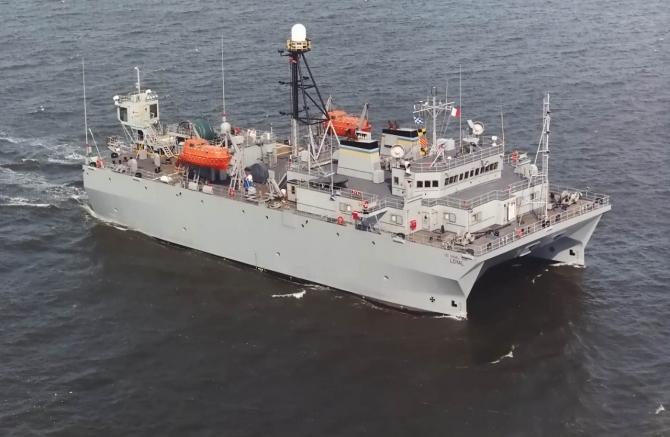Loyal (T-AGOS-22)
The first U.S. Navy ship named for the general word classification.
(T-AGOS-22: displacement 3,384; length 235'; beam 94'; draft 25'; speed 10 knots; complement 34; armament none; class Victorious)
Loyal (T-AGOS-22) was laid down on 7 October 1991 at Morgan City, La., by McDermott Shipyards; launched on 19 September 1992; sponsored by Mrs. Diane Studeman, wife of Adm. William O. Studeman, Director, National Security Agency; and placed in service with the Military Sealift Command (MSC) on 1 July 1993.

Loyal is an MSC-manned ocean surveillance ship that uses primarily the AN/UQQ-2 Surveillance Towed Array Sensor System (SURTASS) to gather underwater acoustical data. The command operates the ship as part of its Special Mission Ships Program, using her to support the antisubmarine warfare operations of the Atlantic and Pacific Fleets. In addition, Loyal carries electronic equipment to process and transmit that data via satellites to shore stations for evaluation. She is built on a small-waterplane, twin-hull design for greater stability at slow speeds in high latitudes under adverse weather conditions, and usually deploys to the Western Pacific Ocean.
Sailors from forward-deployed amphibious ship Essex (LHD-2) and aircrew of Helicopter Sea Combat Squadron (HSC) 25 rescued a mariner of Loyal’s ship’s company on 25 January 2008. The 63-year-old man suffered from stroke-like symptoms while Loyal steamed in the Sea of Japan, and the ship radioed a medical evacuation request to nearby vessels. Essex was not far from the area, en route to Okinawa to embark nearly 1,200 marines and sailors of the 31st Marine Expeditionary Unit (MEU) for her annual spring patrol.
“A male on the Loyal was found by the crew who believed he was having a stroke,” Cmdr. Michael Picio, Essex’s senior medical officer, explained. “The captain radioed for a medical evacuation; we were the closest ship with the ideal medical facilities.” Capt. Anthony Pachuta, Commander Amphibious Squadron 11, directed Essex to respond because she was the closest vessel with a hospital and the ability to transport and stabilize the patient. “We had a situation where there was a merchant sailor that required medical assistance,” Cmdr. William Villareal, Essex’s operations officer, added. “We were able to utilize Essex’s assets to transport the patient from sea to shore. The mission was a success because of the team efforts of Amphibious Squadron 11 and Essex.”
Essex launched a Sikorsky MH-60S Knighthawk from HSC-25 at approximately 1830 carrying Lt. Javier Agraz, the ship’s general medical officer, and Hospital Corpsman 3rd Class Nicolas Rohde, to evaluate the patient. The Knighthawk’s crew comprised Lt. David Frazier, Lt. Andrea Phillips, co-pilot, and Aviation Warfare Systems Operator 2nd Class Bobby Price, Aviation Warfare Systems Operator 2nd Class Robert Thorpe, and Aviation Warfare Systems Operator 3rd Class Heath Smith. The Knighthawk flew nearly 85 miles to reach the surveillance ship.
Because Loyal’s design did not provide a flight deck for the Knighthawk, the helo lowered Agraz 85 feet to the ship’s deck in order to evaluate the patient. Agraz briefly assessed the man and determined that he should be transported to Essex for further evaluation. The Knighthawk crew lifted the patient on board and then the helo returned to Essex. Further testing onboard revealed that the patient likely suffered from an “evolving stroke,” and the medical staff decided to transfer him to the nearest hospital. Essex increased speed and quickly steamed to within 100 miles of Sasebo, Japan. Lt. Cmdr. Michael Service, Commander Fleet Activities Sasebo’s medical regulating officer, arranged for transport to Sogo Medical Hospital for further evaluation and treatment. The helicopter flew the patient to Sasebo, and then returned to Essex at about 2300.
“This was a great example of our naval team pulling together,” Capt. Brian Donegan, Essex’s commanding officer, summarized. “One of our civilian mariners was in need. Uniformed and civilian members of our team, both at sea and ashore, immediately responded to provide help. Everyone performed and executed superbly.”
Detailed history under construction.
Mark L. Evans
4 November 2015


